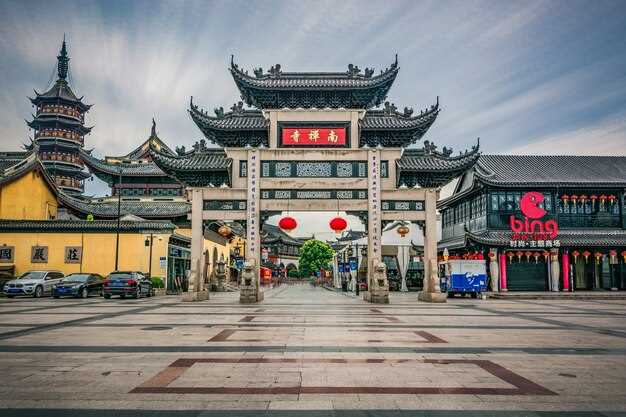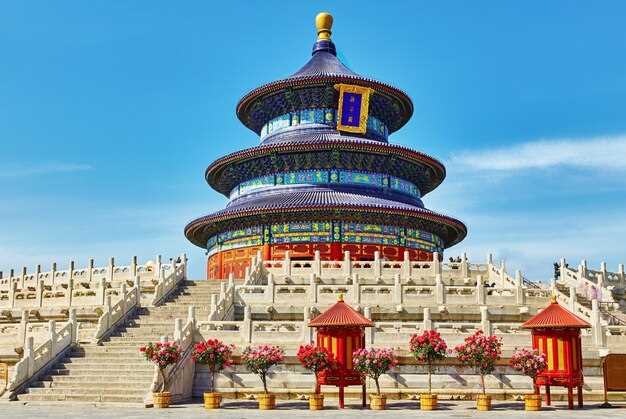Begin with a dawn stroll around tiananmen for instant orientation; taxi to the Forbidden City lifts the experience with a surge of scale. Within the complex, capacity surpasses eighty thousand visitors daily during peak season; temperature in early spring hovers near ten to fifteen Celsius, weather conducive to long walks. This site presents a dynastic power, ritual, administration; a first contact that informs every subsequent corridor.
Eight grand courtyards line the central axis; each facade expresses ancestral meaning through color, carved timber, ceremonial space. The surrounding area hosts majestic gardens, lacquered roofs, precise stone work; the science of urban planning behind this site remains a model studied overseas. Popular routes include the Meridian Gate descent; the Hall of Supreme Harmony; side pavilions provide illumination via multilingual guides, offering clear service to visitors.
Traveling into the city; overseas guests usually start with a stay near the central metro network. Subway lines connect the Forbidden City, Temple of Heaven, Summer Palace; these destinations lie within easy reach. When choosing a district, Hutong neighborhoods deliver deeper pulse; staying within walking distance of a major station saves time. For daily spending, plan a budget of 250–500 CNY for meals, tickets, taxis, plus small souvenirs; taxis are reliable for late hours, a typical fare from the center to northern zones runs around 20–40 CNY.
Gardens such as Beihai Park, the Summer Palace, plus other royal landscapes provide tranquil water, rockeries, pavilions; compared with central corridors, these spaces suit slower pace, shade during heat, cooler mornings, longer stays. Water routes allow boating on lakes; tea houses offer local service with views of bridges, blue skies. Inner courtyards reveal a subtle blend of science, craft, ritual; well preserved within the city limits.
In sum, Beijing offers a compact arc spanning imperial halls, tranquil courtyards, plus dynamic streets; the city works well for first timers, returning travelers, families traveling with kids. Whether you stay near a subway hub, ride a taxi for late hours, or walk through hutongs, this metropolis delivers a perfect balance of grandeur, practical logistics, heritage flavor.
Beijing’s evolution from ancient capital to modern metropolis

Recommendation: Begin at tiananmen Square; take the metro line toward the city core to trace the arc from imperial governance to a modern administrative hub.
The evolution spans several centuries. The architecture at tiantan reveals ritual continuity during the Ming dynasty, Qing dynasty; the surrounding quarter hosted markets, service routes, seasonal rituals; the temperature swings toward hot summers and cool winters. Being a crossroads, the city absorbed influences from nearby lands, while retaining core ceremonial functions.
During the republican era, lugou qiao formed a key link for long march routes to the north; since october 1937 the bridge symbolized wartime mobilization; a tense political mood shaped city planning, military deployments, population shifts.
After 1949, the metropolis served as political center; having a strong army presence influenced urban layout; theater venues multiplying; the olympic moment in 2008 triggered a metro expansion; long construction projects reshaped neighborhoods, pedestrian spaces; public services improved significantly.
Today the line network; long lines; a service-minded approach power access to taoranting, qinglong, tiantan, tiananmen precincts; temperature control measures improve comfort in hot months.
| Period | Milestone | Notes |
|---|---|---|
| c. 15th–16th c. | Tiantan precincts built | Temple of Heaven complex; ceremonial center |
| c. 17th c. | Lugou Qiao established | Linked long caravan routes to the north; qiao |
| october 1937 | Wartime milestone at Lugou Bridge | Symbol of mobilization; political tension |
| 2008 | Olympic Games; metro expansion | Theater venues; urban renewal |
Beijing’s Imperial Legacy: Key dynasties and city-building milestones
Plan a two-day route tracing four main dynasties, highlighting the Forbidden City, tiananmen, west hills, hutong street life, a metro hop for pace.
The Yuan era Khanbaliq grew into the citys core; river routes, supply lines, palace entrances reshaped the map.
Ming administration laid a formal axis through the inner city; the Forbidden Palace defined ceremonial life; ponds, pavilions, towers, walls formed a coherent design; outer precincts have survived well.
Longqing refinements linked river corridors with markets; domestic trade surged; stores lined city streets.
Eight gates defined the cardinal routes; four main axes converge near tiananmen; the west zone anchors imperial reach.
Metro transit supports traveling between districts; fare stays budget friendly; poly planning distributed activity across quarters.
Staying in hutong neighborhoods offers a close look at daily life; summer strolls reveal unique architecture; beauty resides in courtyards. Impressive details visible in woodwork embellish courtyard views. Stay nearby to maximize time.
Compared with modern grids, although imperial schemes show poly planning; citys main axes frame tiananmen, Forbidden City; west hills situated along the skyline.
Night views illuminate the walls; swimming ponds dot imperial grounds; exploring the quarters reveals Longqing era influence; well preserved stonework.
shangdi shihua shidu inscriptions line gates, terraces; these marks help domestic scholars traveling back in time.
Historic sites you must know: Forbidden City, Temple of Heaven, and beyond
Where to start matters: Begin with the Forbidden City, the largest palace complex located in the centre. Arrive early during summer to beat crowds; pricing varies by date, annual passes exist for some visitors; allocate several hours to walk through the line of courtyards, halls, gates; use a map to track each landmark along the axis; bring water, sun protection, plus a weather backup plan.
Temple of Heaven occupies the middle belt of the city, a ceremonial core with vast parkland. The complex unfolds through pavilions, terraces, a circular Mound; the Hall of Prayer for Good Harvests stands as a highlight; consider arriving before 9:00 to avoid peak hours; the line often snags late morning; expected visits still allow a slower pace in the afternoon.
Beyond these icons, explore nanyuan, tanzhe, shidu landscapes, plus the zhongguancun corridor as multiple destinations. источник: local guides note that these routes work well for short visits. Each site yields a different tempo; several routes exist to connect routes, with a bridge crossing framing city views; summer moods shift crowds; pricing varies seasonally; transit options include metro, shuttle buses, or taxis; arrival at airports feeds directly into main terminals; travelers traveling during high season should allocate extra days.
Practical plan covers arrival timing, transport, access. Where to begin, use line 1 to reach centre clusters quickly; pricing for major sites shifts by day, annual passes provide flexibility; travel between clusters via line 1, line 2, line 13; dedicated buses connect airports with main terminals; shihua, yufa districts hold routes frequent enough for day trips; during winterless months, mornings stay cooler, extending sightseeing windows; arrival timing matters for crowds, so plan ahead when traveling from distant destinations.
Modern Beijing: Urban planning, governance, and infrastructure highlights
Prioritize multi-modal transit hubs to cut congestion, boosting urban mobility.
- Transit backbone: Metro expansion; new passenger stations; stops at major dajie corridors; large interchange hubs; feeder buses linking parks, lakes, and markets; passenger flow analyses optimize during peak holiday periods.
- Urban fabric: Core districts preserve best-preserved hutongs; Shichahai and Fayuan areas integrated into modern blocks; narrow lanes retained as heritage routes; towers rise along canyon-like avenues while mixed-use blocks serve home, offices, and commerce.
- Governance and planning: Master plan 2035; whereas district authorities pilot public participation, budgeting transparency, and performance metrics guiding investments; check milestones quarterly.
- Infrastructure and utilities: Upgraded rail station network; smart-grid integration; water management and flood controls; energy networks scaled for large loads; lakeside buffers support climate resilience.
- Public spaces, culture, and hospitality: Parks, fragrant gardens, and large lakefronts anchor urban life; ceremonial plazas host holiday ceremonies; these places remain popular with people; beijings heritage spaces still attract both locals and visitors; polo grounds repurposed for cultural programming.
- Economic vitality and accessibility: Market clusters along dajie attract shoppers; sales networks expand with transit access; hotels along key corridors accommodate visitors during holidays; four major business districts remain busiest; last-mile logistics integrated with pedestrian zones.
- Connectivity and design language: Station-centric layouts concentrate passenger flow; giant towers define skylines; urban blocks form canyon-like canyons that encourage walkability; grasslands-inspired green belts encircle core precincts; nearly all projects undergo rigorous impact checks.
- Heritage and research: Ereсtus-era references appear in exhibits; Shan-area names influence modern placemaking; yufa-guided policies shape conservation parameters for fragile sites; these measures bridge legacy with contemporary growth.
источник: Beijing government (English)
Beijing’s Culture and Arts: Opera, crafts, and culinary scene
Begin with a focused itinerary: watch a Beijing opera; stroll through a crafts quarter near a quiet park; finish with a street-food crawl featuring dumplings, zhajiangmian, brushwork samples.
Imperial echoes populate primary routes: palaces, museums, temple corridors recall eras of emperors; dynasties left buddhist grottoes, fayuan temple, lacquer ateliers around historic sites still considered anchors; sites have significance for visitors.
Beyond central districts lie mutianyu, badachu park, fangshan landscapes; ritan park invites a quiet stroll near a city bridge; ding vessels played ceremonial dining roles in ancient ritual displays.
international traveling impulses shape menus on street corners; trains connect urban centers with quiet valleys; mutianyu sits roughly 80kms away from central districts; amenities at transport hubs include bilingual signage; citytel helplines; importance in guiding visitors; clean restrooms.
Crafts routes weave through hutong clusters; thirteen historic alleys host lacquer shops; porcelain kilns; silk ateliers; imperial motifs appear in patterns and carvings; being keepsakes, each piece carries memory; connoisseurs value every piece.
Milu Park Elk Park: Habitat, conservation, and visiting tips

Plan a morning visit to Milu Park Elk Park; elk activity frequency peaks at first light; tickets usually cost between 15 yuan and 25 yuan; check the official source or CCTV updates for the latest price; opening times listed on the gate board; arrival coordinates align with a road junction near fangshan; badachu serves as a reference point; the nearest terminals offer shuttle buses; a short ride to the park entrance; a bell rings at schedule changes.
Habitat: Milu, called Père David’s deer, thrive in a mosaic like wetlands, grassland; willow groves provide shelter. A shallow lake; reed belts; tree lines furnish cover. Geography features include a network of water channels; the viewing route spans roughly 1.5 kilometre; a tower provides lookout; conservation zones support breeding and food production; unusual seasonal movements appear during mating periods.
Conservation: nation fuels a breeding program; cctv monitoring tracks movements; zizhu, badachu, fangshan form a network extension; population shows stability; unusual seasonal movements appear during mating periods; signboards on site explain Milu origin called Milu; visitors must maintain distance; tickets available at counters; times for operation vary; trains connect from central hubs to a local terminal; transfer to a local bus or taxi; travel time about 30–40 minutes; months with mild weather preferred; CCTV signage provides updates; within the destination there are terminals, including nearby mosques for a cultural stop; bargain attempts near gate discouraged; kilometre loops offer different perspectives; occasional games or school programs in the vicinity may appear; stadium-like pavilion hosts talks during peak season.

 Capital of China – Beijing’s History, Culture, and Top Attractions" >
Capital of China – Beijing’s History, Culture, and Top Attractions" >


















